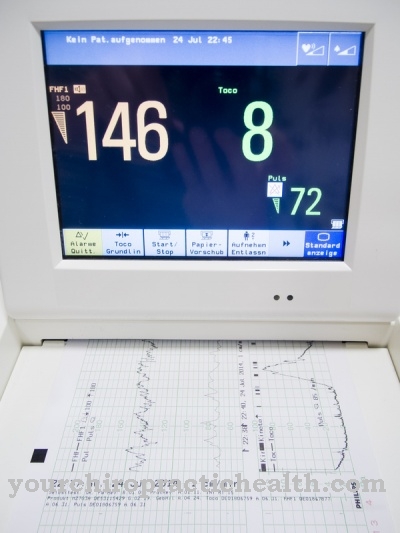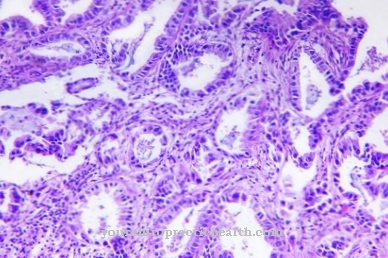The Orthograde intestinal lavage is a preparatory procedure for colon cleansing so that a colonoscopy can be performed afterwards. Orthograde colonic irrigation is also the medical standard when it comes to preparing for certain surgical procedures on the abdomen.
What is Orthograde Colon Irrigation?

Orthograde colonic irrigation is used to prepare for bowel exams so that the doctor has an unrestricted view of the intestinal mucosa during a colonoscopy. Remnants of stool, in particular, can make a clear view of the mucous membrane difficult or even impossible; the corresponding intestinal sections cannot then be diagnosed. As a rule, Orthograde Colon Irrigation is performed the morning before the examination or the day before.
Orthograde colonic irrigation is to be understood as an intestinal cleansing process in which it is necessary that the patient has to orally take in considerable amounts of different fluids for complete emptying of the bowel for a defined period of time. Most patients find this drinking process, but also the subsequent bowel movement, rather uncomfortable, because severe diarrhea can certainly occur.
The first evacuations can be expected about an hour after the oral intake of the rinsing solution has started. The rinsing solutions and medication must be tailored to the patient's body weight and general condition.
Function, effect & goals
Orthograde colonic irrigation begins with the administration of a polyethylene glycol solution, PEG. It is about 3 to 5 liters of solution, which should be drunk completely within just a few hours. The PEG solution is provided with aroma and flavor additives. During the colon cleansing, nothing else should be eaten or drunk, except for clear, non-carbonated water.
To prevent feelings of nausea, a suppository containing the anti-emetic agent dimenhydrinate can also be administered. The orthograde intestinal lavage should be carried out by the patient until only a golden yellow, as clear as possible liquid without solid components is excreted. In order to stimulate the intestinal peristalsis even better, a laxative can be administered in addition to the rinse. If patients suffer from chronic constipation as a result of laxative abuse, then the additional administration of a laxative is mandatory, otherwise the goal of a completely clean intestinal mucosa can hardly be achieved.
Also, some patients cannot ingest large amounts of fluids in such a short time. In these cases, it is possible to administer the irrigation solutions via a gastric tube, a variant that is even preferred by some patients. Shortly before the examination, a so-called high enema may also be required, to which the laxative bisacodyl is added. This laxative has an immediate laxative effect and removes the last remnants of stool from the anus. The orthograde intestinal lavage is used in particular to prepare for major abdominal operations, to prepare for a so-called colonic contrast enema and for complete emptying of the bowel before a colonoscopy, jejunostomy and ileoscopy.
The preparatory actions for an orthograde colonic irrigation also include medical information about the purpose and risks. The risks of orthograde colonic irrigation itself are very low; the risks of the subsequent examinations are much higher. In the consultation with the doctor, all of the patient's questions about the procedure and implementation of the orthograde colonic irrigation are discussed in detail. Orthograde colonic irrigation is one of the medical examinations that require documentation, so the doctor has an extensive duty to inform.
The result of the conversation is documented in writing with the signatures of the doctor and the patient. The preparation also includes a physical examination with determination of the initial weight. The materials required for a stationary orthograde colon irrigation include a toilet chair, a so-called bedpan and a balance sheet for the supplied liquid. In addition to the actual rinsing liquid, the patient can also drink up to 12 liters of isotonic saline solution, which usually leads to deliberate osmotic diarrhea.
Follow-up work after the examination is complete is also important. The patient must continue to be observed and his vital signs, consciousness and fluid balance monitored for a period of time individually defined by the doctor. Orthograde colonic irrigation can also be performed on incontinent patients if so-called incontinence clips are applied beforehand. All materials used must be disposed of properly.
Risks, side effects & dangers
In the case of certain contraindications, orthograde colonic irrigation cannot be performed because the risks are too high. The absolute contraindications include mechanical and paralytic ileus, intestinal stenoses of other origins, bleeding and severe inflammation of the gastrointestinal tract as well as severe cardiac and renal insufficiency.
Because if the heart or kidneys are seriously ill, the large amount of fluid involved in orthograde intestinal irrigation can quickly lead to significant, even life-threatening complications. The degree of inefficiency of the heart or kidneys results from the previous medical findings through physical examination, imaging procedures and laboratory values. In each individual case, a doctor must therefore decide whether or not orthograde colonic irrigation can be performed.
Orthograde colonic irrigation is frequently mistaken for an enema. However, this is not used for diagnostic purposes, but only for the rapid elimination of constipation. It happens again and again that an orthograde colonic irrigation has to be stopped prematurely. Unknown or unrecognized previous illnesses can suddenly lead to changes in vital signs due to circulatory problems, which result in an immediate interruption of the flushing procedure. Even if the patient suffers from severe abdominal cramps or pain after using the irrigation solution, the orthograde intestinal irrigation must be stopped prematurely.
The administration of painkillers while an orthograde colonic irrigation is in progress is not common and reserved for exceptional cases. Even if the patient suffers from severe abdominal cramps or pain after using the irrigation solution, the orthograde intestinal irrigation must be stopped prematurely. The administration of painkillers while an orthograde colon irrigation is in progress is not common and is reserved for exceptional cases.

.jpg)






.jpg)



















